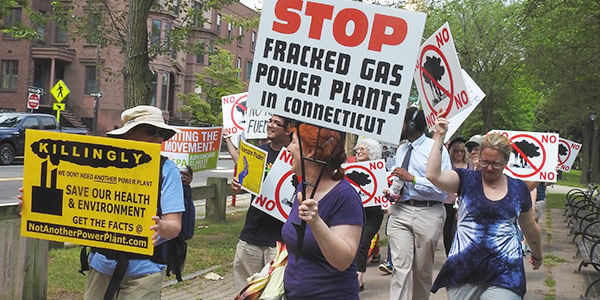By Michael Kuser
HARTFORD, Conn. — About 40 environmental activists marched Wednesday in front of the headquarters of Connecticut’s Department of Energy and Environmental Protection to protest state regulators’ recent approval of a new gas-fired power plant in the town of Killingly.
The Connecticut Siting Council on June 6 approved construction of the 650-MW Killingly Energy Center by Florida-based developer NTE Energy, permitting the plant to emit up to 2.2 million tons of carbon dioxide each year.
The organizers included Connecticut Fund for the Environment, Not Another Power Plant, the state chapter of the Sierra Club and Wyndham Land Trust.

Environmental activists marched Wednesday in front of DEEP headquarters to protest the approval of a 650-MW power plant in Killingly, Conn. | © RTO Insider
Sierra Club volunteer Martha Klein led the protesters in a chant on the steps of DEEP headquarters: “Hey, hey, ho, ho, Katie Dykes has got to go!” — referring to the DEEP commissioner.
“I’ve got a simple one-word answer for why Connecticut keeps expanding fracked methane despite knowing that it’s destroying our climate: It’s ‘corruption,’” Klein said. “It’s equal opportunity corruption, for we’ve had both a Republican governor [John Rowland] and a Democrat mayor [Hartford’s Eddie Perez] go to jail.” Neither politician was convicted of illegal activity related to the energy sector.

Martha Klein, Sierra Club | © RTO Insider
Klein told RTO Insider that “when the state approves new power plants run on fracked gas or oil, that’s going to exacerbate climate change.”
Ann Gadwah, chair of the state’s Sierra Club chapter, said, “This plant is totally unneeded. New England doesn’t need the power, and Connecticut doesn’t need the power.”
Gadwah said regulators seem to have forgotten that the state legislature passed a law requiring DEEP to monitor air quality in the eastern part of the state after New York approved construction of the 1,100-MW natural gas-fired Cricket Valley Energy Center, which is slated to go online next year and the emissions of which would generally blow into Connecticut from its site just west of the state line.
RTO Scapegoat
James Albis, a senior advisor to Dykes, spoke to activists and reporters at the protest and handed out flyers with questions and answers on Killingly.
On why the plant is being built, DEEP said, “It was procured through the regional ISO New England capacity market auction to meet regional reliability needs. It will help address reliability needs in the winter because of its dual-fuel capability, allowing it to run on ultra-low-sulfur diesel during peak times when natural gas is constrained, which is a cleaner alternative to other baseload peaking generators.”

KEC Site Location | NTE Energy
In response to the question of who will pay for the plant, the department said the state “does not have any contractual obligations with Killingly. The plant cleared in the regional [ISO-NE] market that Connecticut participates in, but NTE (the developer) bears the risk of participating in the market and the potential for stranded costs as Connecticut moves to a zero-carbon future.”
Melinda Fields came to protest from Hampton, a few miles west of Killingly.
“I protested the Siting Council meeting too,” Fields said. “It seemed like they only wanted to help the company get what it wanted; like, ‘what can the state do for you?’”
The area’s state senator, Mae Flexer, submitted testimony stating that Connecticut Economic Resource Center data indicate that Killingly would become the second-largest power generation town in the state if the plant is built, behind only Waterford, site of the Millstone nuclear plant.

Independent activist Cher Kapelner-Champ | © RTO Insider
“This would be an enormous burden to place on the people and environment of Killingly,” Flexer said. “To require so much of the state’s electricity to be generated here and — along with it — to concentrate such a large percentage of the state’s pollutants and emissions from power generation in this town is grossly unfair.”
Veteran activist Cher Kapelner-Champ said she had been among 1,200 people arrested in 1977 for protesting the construction of the Seabrook nuclear plant in New Hampshire.
“They built Seabrook anyway, so why do I keep protesting?” she said. “As a great Hebrew scholar once said, we all just bring our one teaspoon of compassion — and you never know when the tipping point will come.”


